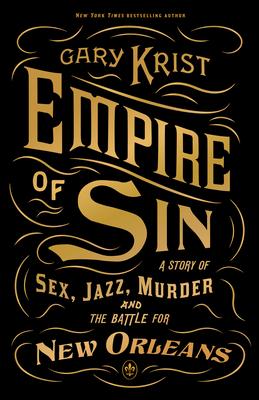
New Orleans, Louisiana, has to be one of the more fascinating cities in the United States. Its European vibe, the amalgam of cultures, its decadence, and anything goes attitude make it a place to visit for many people. In reading Empire of Sin by Gary Krist, I hoped to learn more about the city’s past to bridge the gap in my knowledge of the city’s history. I didn’t exactly get what I wanted, and what I did get was not presented in as interesting a fashion as I hoped it would be for such an exuberant city.
Mr. Krist’s novel covers New Orleans from the post-Reconstruction period to the Roaring Twenties. There were Mafia turf wars and racial equality that soon morphed into a burgeoning Jim Crow sentiment during this time. Most important to this period is the idea that the city leaders had of limiting all of the city’s vices – alcohol, prostitution, gambling, interracial relationships, and jazz – to a few specific blocks of the city called Storyville or the Tenderloin district.
While Mr. Krist starts and ends his novel with a string of unsolved murders that may have been Mafia-related and may have been due to a serial killer, he spends most of his time following Storyville from its beginning to its demise. We learn, repeatedly, all about the incredible profits to be had by sin, the influx of shadier and more violent businessmen from New York City, and the increasing cry from the conservative temperance and other reformers to shut down Storyville. While something similar happened in many of the larger cities in the United States, what makes New Orleans so different is the sheer extent to which it embraced Storyville. In fact, stories about happenings in Storyville made their way to Europe as proof that the debauchery occurring in NOLA knew no bounds.
I learned from Empire of Sin that the more things change, the more things stay the same. Eventually, city businessmen see Storyville as a bane to the city and a deterrent to potential capital investors. At the same time, the Victorian attitude of believing certain sins like sex and drink were best kept outside the house changes. It takes thirty years and lots of money, but eventually, the reformers shut down Storyville, forcibly evicting everyone who lives within the district.
There are several ironies about the end of Storyville. First, the timing of Storyville’s end is odd. While the rest of the country entered the Roaring Twenties and its looser standards, New Orleans went in the opposite direction. With the end of Storyville came the complete and total migration of its more famous jazz musicians away from New Orleans. Again, while the rest of the country was enjoying the music that Storyville created, New Orleans was not.
Then there is the fact that not thirty years after the city officials won its ar against vice, it started encouraging it again through the revamping of the French Quarter. Essentially, the French Quarter as it exists today is a tamer version of Storyville. So, what once was a deterrent to business is now one of the city’s biggest attractions.
There is no doubt that Mr. Krist did careful research to present his story. I especially appreciate that he clarifies that any quotes in the book are verifiable quotes taken from original sources. These sources include police statements, newspapers, and people like Jelly Roll Morton and Louis Armstrong. For a history that people could easily take as too incredible to be accurate, his use of original sources removes the incredibility.
While I learned a lot from Empire of Sin, I struggled to get through the book. Mr. Krist’s writing style is comprehensive and less than exciting. Also, he throws so much at the reader – the Mafia thing, the murders, Storyville, and the birth of jazz. While it all occurs during the period of the book, it is too much. I wanted him to finish one story before he started another. Instead, he weaves them together, so you don’t quite understand what the Mafia and Storyville have to do with one another other than that the turf wars coincided with the battle for Storyville. I appreciate Mr. Krist’s use of original sources, but at the end of the day, any story about New Orleans should be more exciting or at least more interesting than what I got with Empire of Sin.











Related Stories
- Toss a coin to your witcher
- This is not the university experience I had
- Be careful of who you befriend at the beach



